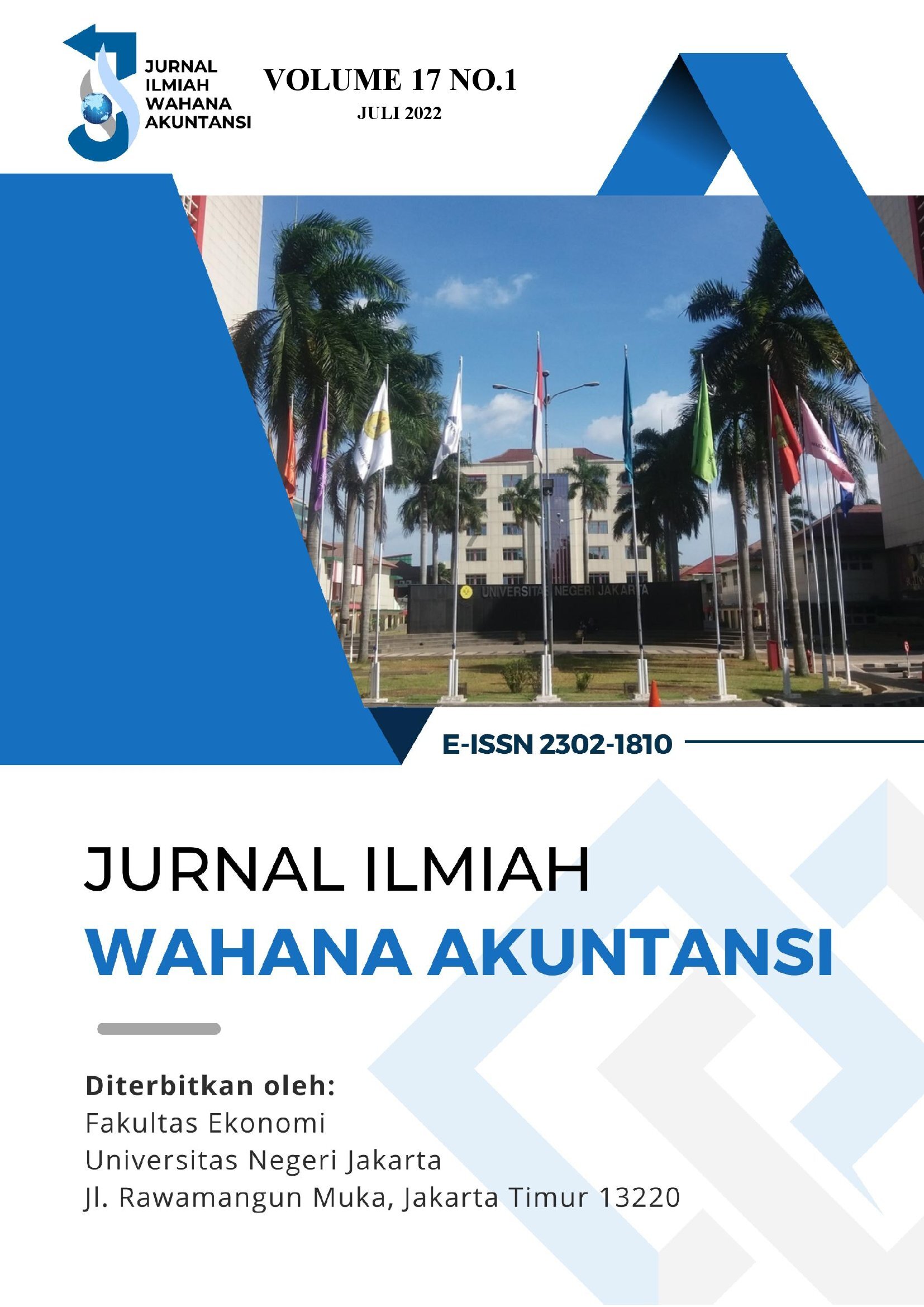Effect of Dividen Policy on Abnormal Return with Earning Information as a Moderating Variable
DOI:
https://doi.org/10.21009/wahana.17.017Keywords:
Dividend Policy, Earning Information, Abnormal Return, Siganling Theory, Efficient MarketAbstract
This research was conducted with the aim of knowing the effect of dividend policy on abnormal returns with earnings information as a moderating variable. The purposive sampling method was used as a sampling technique with 22 selected companies from 45 companies listed on the LQ45 index on the Indonesia Stock Exchange (IDX) from 2016 to 2020. This study used secondary data source obtained through the Mirae Asset Home Online Trading System software to obtain information related to dividends and share prices, and IDX website to obtain the publication of annual reports to obtain information related to company profits. The results of this study indicate that dividend policy has a negative effect on abnormal returns. Meanwhile, earnings information has not been able to moderate the effect of dividend policy on abnormal returns.
References
Agustina, L., & Kianto, F. (2012). Pengaruh Informasi Laba Akuntansi Terhadap Abnormal Return pada Perusahaan yang Tergabung Dalam Indeks LQ45. Jurnal Akuntansi, 4(2), 135–152.
Agustina, & Sumartio, F. (2014). Analisa Faktor-Faktor yang Mempengaruhi Pergerakan Harga Saham pada Perusahaan Pertambangan. Jurnal Wira Ekonomi Mikroskil, 1(1), 51–61.
Al-Yahyaee, K. H. (2015). Security Returns During Ex-Dividend Period. Procedia Economics and Finance, 30, 948–954. https://doi.org/10.1016/s2212-5671(15)01345-3
Andersson, U., Cuervo-Cazurra, A., & Nielsen, B. B. (2014). From the Editors: Explaining Iteraction Effects within and Across Levels of Analysis. In Journal of International Business Studies(Vol. 45, Issue 9, pp. 1063–1071). Palgrave Macmillan. https://doi.org/10.1057/jibs.2014.50
Baron, R. M., & Kenny, D. A. (1986). The Moderator-Mediator Variable Distinction in Social Psychological Research: Conceptual, Strategic, and Statistical Considerations (Vol. 51, Issue 6). Psychological Association, Inc.
Brigham, E. F., & Houston, J. F. (2020). Fundamentals of Financial Management.
Dewi, N. P. S., & Putra, I. N. W.A. (2013). Pengaruh Pengumuman Right Issue pada Abnormal Retrun dan Volume Perdagangan Saham. E-Jurnal Akuntansi Universitas Udayana, 3(3), 163–178.
Dwipayana, I. G. N. A. P., & Wiksuana, I. G. B. (2017). Pengujian Efisiensi Pasar di Bursa Efek Indonesia. E-Jurnal Manajemen Unud, 6(4), 2105–2132.
Felicia, & Salim, S. (2019). Pengaruh Ukuran Perusahaan, Informasi Laba, Kebijakan Dividen dan Leverage Terhadap Abnormal Return. Jurnal Multiparadigma Akuntansi, 2, 372.
Fu, Y., & Blazenko, G. W. (2015). Returns for Dividend-Paying and Non Dividend Paying Firms. International Journal of Business and Finance Research, 9(2), 1–20. www.theIBFR.org
Hadi, N. (2020). Pasar Modal (2nd ed.). Graha Ilmu.
Haryanti, Y., & Murtiasih, S. (2019). The Effects of DER, ROA and DPR on Stock Price with EPS as the Moderating Variable in SOE. IOSR Journal of Business and Management, 21(7), 1–08. https://doi.org/10.9790/487X-2107040108
Idawati, W., & Wahyudi, A. (2015). The Effect of Return on Assets and Earnings per Share and Dividends per Share on Stock Price of Publicly Listed Banks in Jordan. Journal of Resources Development and Management, 7(5), 71–91. www.bakrieglobal.com
Jogiyanto, H. (2017). Teori Portofolio dan Analisis Investasi(11th ed.). BPFE-Yogyakarta.
Ngoc, D. B., & Cuong, N. C. (2016). Dividend Announcement and Ex-Dividend Effects on Stock Return. International Journal of Economics and Finance, 8(7), 207–2015. https://doi.org/10.5539/ijef.v8n7p207
Pratama, G. (2019). Efisiensi Pasar Modal Indonesia pada Tahun Pemilu 2019. Journal of Economic, 10(2), 169–179.
Purwohedi, U. (2022). Metode Penelitian Prinsip dan Praktik. Raih Asa Sukses.
Rahayu, Y. S., & Wardana, G. K. (2021). The Effect of Financial Performance and Dividend Policy on Cumulative Abnormal Rerturn. Jurnal Keuangan dan Perbankan Syariah, 9(1), 62–76.
Ross, S. A. (1977). The Determination of Financial Structure: The Incentive-Signalling Approach. The Bell Journal of Economics, 23–40.
Sa’adah, L., & Kadarusman. (2014). Pengaruh Laba Akuntansi, Komponen Arus Kas, Ukuran Perusahaan Terhadap Harga Saham pada Perusahaan Kelompok LQ 45 yang Listing di Bursa Efek Indonesia. Jurnal Manajemen dan Akuntansi, 3(2), 15–29.
Saputra, A. L. D., & Darsono. (2015). Reaksi Pasar atas Pengumuman Dividen Tunai (Studi Empiris pada Perusahaan Lq-45). Diponegoro Journal Of Accounting, 4(4), 1–14. http://ejournal-s1.undip.ac.id/index.php/accountingISSN
Sathyanarayana, S., & Gargesha, S. (2017). The Impact of Policy Announcement on Stock Market Volatility: Evidence from Currency Demonetisation in India. IOSR Journal of Business and Management, 19(01), 47–63. https://doi.org/10.9790/487x-1901074763
Spence, M. (1973). Job Market Signaling. In The Quarterly Journal of Economics (Vol. 87, Issue 3).
Sutejo, B. S., & Utami, M. (2020). Abnormal Return Testing Before and After the Earnings Announcement. Business and Management Research, 115.
Syofyan, R., Putra, D. G., & Aprayuda, R. (2020). Influence of Company Value Information, Dividend Policy, and Capital Stucture on Stock Price. Soedirman Accounting Review, 6(2), 138–169. http://jos.unsoed.ac.id/index.php/sar/
Triana, C., & Lukman, H. (2021). Pengaruh Profitability, Pbv, Firm Size dan Dividen Terhadap Abnormal return. Jurnal Multiparadigma Akuntansi, III(4), 1787–1795.
Umdiana, N. (2014). Abnormal Return (Studi Empiris pada Perusahaan Manufaktur Sektor Industri Konsumsi yang Terdaftar di BEI 2008-2012). Jurnal Akuntansi, 1(1).
Downloads
Published
How to Cite
Issue
Section
License

Jurnal Ilmiah Wahana Akuntansi is licensed under a Creative Commons Attribution-NonCommercial-ShareAlike 4.0 International License.
Articles in Jurnal Ilmiah Wahana Akuntansi are Open Access articles published under the Creative Commons CC BY-NC-SA License. This license permits use, distribution and reproduction in any medium for non-commercial purposes only, provided the original work and source is properly cited. Any derivative of the original must be distributed under the same license as the original.











